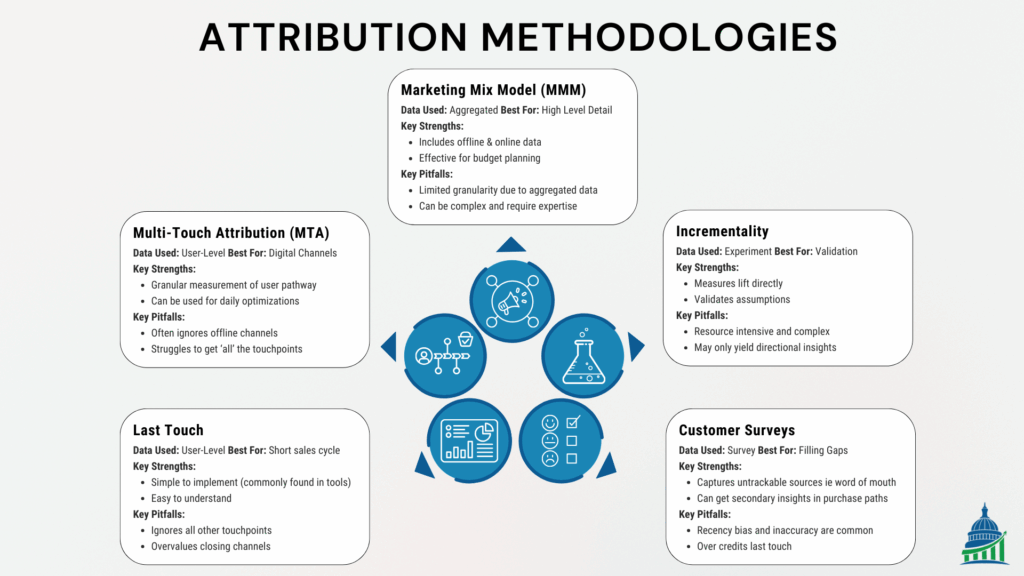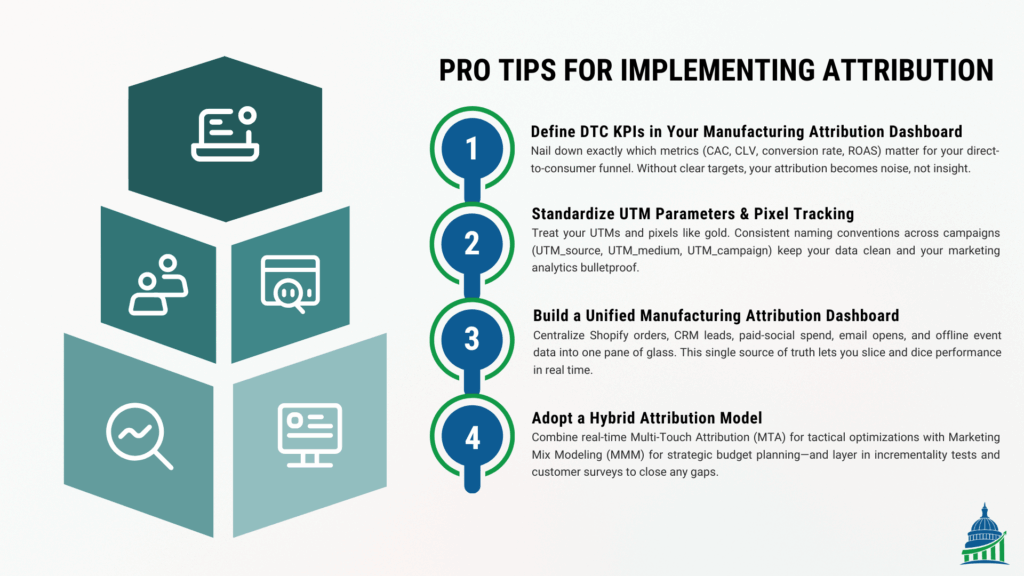As an American-made manufacturer, you've relentlessly optimized your production line, yet three hidden wastage points beyond your view still threaten your profitability and even your business survival.
Read MoreDo you loathe the feeling you get every time you look at your marketing spend? Does the marketing and sales component of your business feel like a black box? These are all too common feelings amongst American made DTC owners. Don’t fret, this article acts as a master guide to alleviate sense of loathing and turn marketing data into a superpower for your business.
In this article we are going to focus on the most important topic in marketing and sales, marketing attribution. By the end of the article, you will know why you should care about attribution, key metrics you must track, attribution methodologies and finally pro tips to avoid pitfalls.
Marketing is no longer linear—it’s a marathon of emails, social media, pop-up events and paid ads that push purchase journeys across multiple days, weeks, or even months. As these touchpoints balloon it becomes hyper-critical to deliver crystal-clear visibility into how every marketing dollar drives sales. This is the goal of attribution at its core. Attribution seeks to answer the questions “Which marketing channels are most effective?” and “How much does each marketing touchpoint contribute to sales?”
Knowing the answers to those two questions can unpack the black box of marketing and deliver three key outcomes for your business:
Knowing that attribution is important and how it serves you is the first step in battle. The next step is understanding the three key metrics that you must absolutely be maniacal about tracking if you want to have the attribution crystal ball working.
Return on Advertising Spend (ROAS)
Customer Acquisition Cost (CAC)
Customer Lifetime Value (CLV)
At the heart of every data-driven manufacturing marketing strategy lies a set of distinct attribution frameworks. Here’s how today’s top DTC brands measure what truly matters:

Last touch attribution is one of the most common and easy to implement versions of attribution. It is what is readily available in your platforms like Google Analytics and is something that most marketers still utilize. It is better than nothing, but it will underweight top of funnel touchpoints by completely ignoring them.
MTA is a process that requires tracking every touchpoint in a customer’s journey and picking a strategy to assign credit to those touchpoints. This works best in a digital environment within your control, but due to the limitations of tracking you will struggle putting together that all-encompassing touchpoint database.
Common Versions:
• Linear: Splits credit equally across all interactions.
• Time Decay: Rewards touchpoints closest to conversion.
• Position-Based (U-Shaped): Emphasizes first and last touches.
• Data-Driven/Algorithmic: Leverage statistical processes to more closely mirror your customer purchase pathways.
MTA FAQ:
What are the benefits of multi-touch attribution compared to single-touch models?
Multi-touch attribution provides a balanced view by crediting all touchpoints in the customer journey, enabling better budget allocation and ROI optimization, unlike single-touch models that overemphasize one interaction (e.g., first or last click).
What are the limitations of multi-touch attribution for tracking offline or non-click interactions?
MTA struggles to track offline channels (e.g., TV, radio) and non-click interactions (e.g., in-app offers), as these lack digital footprints, leading to incomplete attribution and undervalued offline efforts.
How can I use MTA to optimize my daily marketing spend?
MTA identifies high-performing channels and touchpoints in real-time, allowing granular adjustments (e.g., shifting budgets to top creatives or keywords) for immediate campaign optimization.
MMM is a top-down approach to attribution, meaning no need for collecting all those pesky customer touchpoints. The downside is obvious; you won’t get a good look at your customer purchase pathways. However, it does shine when it comes to budget optimization and multi-channel interactions.
Common Versions:
• Linear Regression Models: The classic approach, using multiple linear regression to relate sales to marketing variables and external factors. This is the foundational method for most MMM analyses.
• Bayesian Models: Modern MMMs increasingly use Bayesian statistical techniques, which allow for the incorporation of prior knowledge and uncertainty, and are well-suited for complex, multi-channel environments.
• Machine Learning Models: Some advanced MMMs leverage machine learning algorithms for variable selection, nonlinear relationships, and forecasting, supplementing or replacing traditional regression.
MMM FAQ:
How can MMM inform long-term marketing budget decisions?
MMM identifies optimal budget allocation across channels and enables scenario planning by simulating the impact of future spend adjustments, helping brands prioritize high-impact investments for sustained growth.
How does MMM differ from multi-touch attribution in measuring marketing effectiveness?
MMM evaluates both online/offline channels and external factors (e.g., market trends) for long-term strategic insights, while MTA focuses on short-term digital touchpoints, often missing holistic contributions.
What are the challenges of implementing MMM for smaller DTC brands?
MMM requires extensive historical data (1-3 years) and technical expertise, posing hurdles for smaller brands with limited data-collection capabilities or resources to manage complex modeling.
Incrementality tests are used to measure the impact of marketing activities by how much additional sales are generated. This is usually done through controlled experiments such as geo or holdout testing. Both of these forms of testing require you to split your potential customers into two groups by either geography or control and then measure the difference between the responses in groups.
Incrementality FAQ:
What is the difference between incrementality and attribution?
Attribution assigns credit to marketing touchpoints that precede a conversion, while incrementality measures the true causal impact of marketing by determining how many conversions were directly generated by a campaign versus what would have happened without it.
How can incrementality testing help prove the true value of my marketing spend?
Incrementality testing quantifies the additional revenue or conversions directly attributable to a campaign, enabling marketers to accurately assess return on ad spend and make informed decisions about budget allocation.
What are the best practices for running incrementality experiments?
Best practices include clearly defining your hypothesis, selecting appropriate test and control groups (such as geo or audience splits), ensuring statistical significance, and maintaining clean separation between groups to isolate the true effect of your marketing intervention.
Surveying customers for purchase information is a good way to collect information on sources that are not easy to measure such as word of mouth or offline channels. It is filled with potential biases, but it should not be altogether ignored as some would make you believe. Using surveys can help you get a more holistic view of your customer’s perception of the customer journey unlike the other methods.
Self-Reported Attribution FAQ:
What questions should I ask customers to understand their purchase journey?
Ask open-ended questions like “Where did you first hear about us?” and include options for untrackable sources (e.g., word-of-mouth, radio) to capture awareness drivers, while avoiding biased multiple-choice formats that limit insights.
How reliable are self-reported attribution methods?
Self-reported data is prone to memory bias, recency effects, and inaccuracies (e.g., users misremembering sources), but it uniquely captures offline or untraceable influences like referrals that digital models miss.
How do I combine survey data with digital attribution models?
Integrate self-reported responses (e.g., from forms or post-purchase surveys) into multi-touch attribution dashboards to fill gaps in tracked data, creating a hybrid model that balances quantitative and qualitative insights.
Many DTC brands start with last-touch attribution because it’s built into platforms like Google Analytics—but it’s a blunt instrument that undervalues every earlier interaction. Stepping up to multi-touch attribution gives you channel-by-channel credit, whether you use linear, time-decay, or algorithmic models. MMM then overlays a statistical lens on your entire marketing mix, and incrementality tests confirm which campaigns truly moved the needle. Self-reported attribution via customer surveys rounds out the picture by revealing hidden influences like referrals. By combining these methods—leveraging MTA for daily optimizations, MMM for budget planning, incrementality for validation, and surveys for holistic feedback—you create a DTC attribution framework that transforms manufacturing marketing analytics into a precision tool for profit growth.

Don’t let another marketing dollar disappear into the void—sales attribution gives you the clarity to invest in what truly moves the needle for your American-made DTC brand. If you’d rather spend your time perfecting products than wrestling with data, let our team build and implement a custom attribution dashboard for you. Click here to schedule a free call, and let’s turn your marketing black box into a profit-driving machine.
As an American-made manufacturer, you've relentlessly optimized your production line, yet three hidden wastage points beyond your view still threaten your profitability and even your business survival.
Read MoreA three video series that explores propensity models.
Read MorePropensity models are a group of statistical models that provide immense value to your organization.
Read MoreNEED MORE ANSWERS ON HOW TO WIN THE WAR AGAINST CHEAP CHINESE CRAP? WE’D BE HONORED TO PROVIDE SOME CUSTOMIZED FREE GUIDANCE.